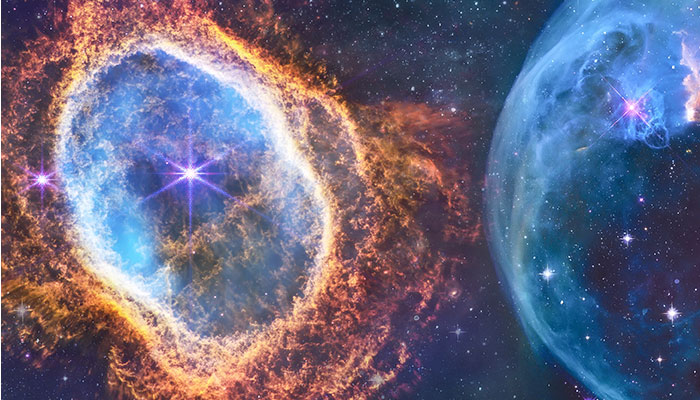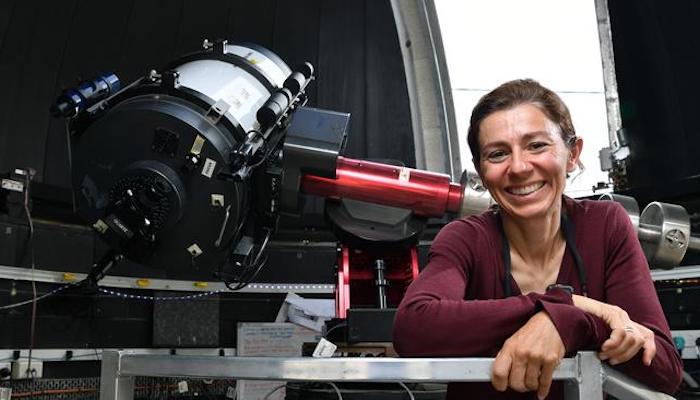‘This was a star that lived fast and died young’: James Webb Space Telescope images show a star’s murder scene

Among the first five image sets from the James Webb Space Telescope (JWST) released in July were a set of remarkably detailed photographs of the Southern Ring Nebula, a stunning nebula about 2500 light years away.
The source of this expanding cloud of gas, whose inner diameter is nearly 400 times the size of our solar system, is a dying star releasing gas and dust over a timespan of tens of thousands of years – and which may be affected by up to three nearby companion stars. The star was 530 million years old as it died, a fraction of our own Sun’s current age of five billion years.
“This was a star that lived fast and died young, compared to our five-billion-year-old Sun that is unlikely to eject its own planetary nebula for another five billion years,” says astronomy professor Orsola De Marco, from Macquarie University’s Research Centre for Astronomy, Astrophysics and Astrophotonics.
De Marco is lead author on a research paper published in Nature last week. She co-authored the paper with more than 60 other astronomers from 21 countries, which suggests fascinating theories and models to explain puzzling patterns and complex structures the new images reveal within the gas cloud.
“To reconstruct the death of the star that spawned this cloud, the planetary nebula itself can be viewed like a murder scene,” she says.
Planetary nebulae have nothing to do with planets, she adds, and are typically a giant cloud of gas surrounding one or more stars.
“Nebulae were nicknamed ‘planetary nebulae’ by the astronomer William Herschel in the 1780s, because their rounded shapes reminded him of how planets looked through a telescope,” she says.
Spiral tracks reveal a multi-star system
The dying star in the middle of the Southern Ring nebula (whose formal and far less-imaginative astronomical name is NGC3132) is today a white dwarf, but in its youth had 2.9 times the mass of our Sun.
De Marco says the infrared light from the hot star illuminated a dusty disk and spiral tracks, providing strong clues about the stars that make up this nebula – and the role they may have played in the central star’s death.
“The images show spiral tracks that look like broken arches in the nebula’s halo – which tells us that there’s a companion star orbiting nearby, at 40 to 60 times the Sun-Earth distance,” she says.
“One or even two companion stars closer still are likely responsible for the formation of a dusty disk that was first detected by JWST, as well as for numerous protuberances we can see in the walls of the ionised nebular cavity,” she says.
The gravitational forces of two or three companion stars in this close system likely hastened the demise of the now-dying white dwarf – which in turn may have cannibalised one or two of its companion stars.
The group agrees the dying star was “at least a stellar quartet” and developed a model showing how it could have created the dusty disk and the spiral tracks observed in the halo of the nebula.
The dying star at the nebula’s source sits obviously next to a bright star which is also an associated companion – but De Marco calls this highly obvious star an innocent bystander, too far from the crime scene to have taken part in the central star’s demise.
Bright bystander helps track star’s decay
The bright “innocent bystander” star did serve one useful purpose though: it played a key role in helping astronomers calculate the changing mass of the white dwarf over its lifetime.
“The single biggest problem we have in galactic astronomy is working out the distance to astronomical objects, so when we see a star with a certain apparent brightness, we ask – is it dim and close? Or is it bright and far away?” says De Marco.
“This bright, bystander star in the nebula had its distance accurately measured by the Gaia space observatory, and since we know it resides inside the nebula, we now know the distance to the nebula itself and its originating star,” she says.

With the distance known, the JWST images allowed astronomers to calculate the most precise value we’ve ever had, for the original mass of a star that makes a planetary nebula.
In this case, the source star was originally 2.9 times the size of our own Sun; additional modelling tells us the mass of the star as it is today: 0.6 times the mass of our Sun.
As President of the International Astronomical Union Commission focusing on Planetary Nebulae, De Marco is one of the world’s leading authorities on these nebulae.
As these gas clouds drift into interstellar space they carry away new elements created within the star, like carbon and nitrogen, that ultimately form new stars and planets.
Nebulae are the spectacular clouds of cosmic gas and dust that form as dying stars that were originally up to 10 times the mass of our Sun, shed their outer layers, become white dwarf stars and then ebb away.
As these gas clouds drift into interstellar space they carry away new elements created within the star, like carbon and nitrogen, that ultimately form new stars and planets.
“Studying planetary nebulae helps us understand the cosmic recycling of chemical elements that result in galactic evolution,” says De Marco.
On July 12, NASA released images of the Southern Ring nebula from both the near-infrared and the mid-infrared James Webb Space Telescope cameras, each collecting different light wavelengths that can see much fainter and with far better resolution than other space telescopes.
How astronomers from over 20 countries decoded the JWST images
Phones, emails and astronomy message boards ran hot as nebulae specialists worldwide conferred with each other over what could be causing various patterns such as spirals and bumps appearing in and near the ionised cavity around the dying star.
“The mid-infrared picture showed the dying star – which is really hot, at 130,000 Kelvin – shining as bright as its companion, but that made no sense because the mid-infrared wavelength shows cool objects,” she says.
“Then we thought, perhaps that’s because the hot dying star is shrouded in dust – something that is known to happen occasionally when the hot star has a dusty disk.”
Astronomers gathered online, theories and models were developed, and De Marco co-ordinated the resulting paper published in Nature Astronomy on 8 December, “The messy death of a multiple star system and the resulting planetary nebula as observed by JWST.”
Astronomers in the final paper came from Australia, Belgium, Brazil, Canada, France, Germany, Greece, Hong Kong, Hungary, Ireland, Israel, Italy, Japan, Mexico, South Africa, Spain, Sweden, Taiwan, The Netherlands, UK and USA.

The group agrees that the dying star was “at least a stellar quartet,” and have developed a model showing how it could have created the dusty disk and the spiral tracks observed in the halo of the nebula.
The images have also helped the astronomers gain insights into astrophysical processes including colliding winds, and binary star interactions, says De Marco.
“Our own Sun’s death in around five billion years could also spawn a planetary nebula, but since the Sun is likely a single star, that nebula won’t be nearly as spectacular as the Southern Ring nebula,” she says.
Professor Orsola De Marco is Professor of Physics at Macquarie University’s Astronomy Astrophysics and Astrophotonics Research Centre and Professor, School of Mathematical and Physical Sciences.
This article was first published on The Lighthouse, Macquarie University’s multi-media publishing platform.
 Related: First images from James Webb Space Telescope reveal distant galaxies in mind-blowing detail
Related: First images from James Webb Space Telescope reveal distant galaxies in mind-blowing detail




